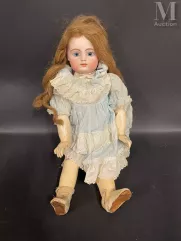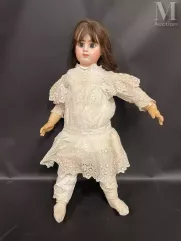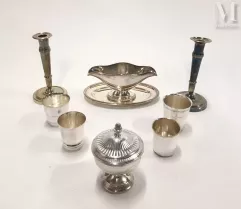Do you own a Hornby train and want to find out its auction value?
Our auctioneers and experts in the Antique Toys give you some hints to find out more about your Hornby train and find out its value on the art market.
In this article, discover the history and characteristics of Hornby trains, learn how to estimate it and find out its auction price!
The Hornby train, star of model railways
In the world of model railroading, Hornby is a manufacturer that enchants enthusiasts. The brand first appeared over a century ago, in the 1920s. Hornby trains have been popular since their launch. They are renowned, for example, for the faithful detailing provided by the manufacturer. Behind this famous brand is Frank Hornby, a British inventor specializing in toys. He is also the creator of other famous brands of play products, such as Dinky Toys and Meccano.
Hornby trains are made, at the very beginning of production, from printed sheet metal, then from a variety of materials, including metal, plastic and wood. These scale models represent locomotives, passenger cars and freight cars of various sizes.
Different scales are, in fact, offered, such as the O scale of 1:43e and the OO scale of 1:76e and the HO size (1:87). The Hornby brand also offers a variety of accessories to accompany its trains: items on offer range from buildings to signals to landscape pieces.
Estimating a Hornby train
There are several things to bear in mind when estimating a Hornby train.
The model and its age
The oldest models are in lithographed sheet metal, These are the most sought-after trains.
The trains manufactured at the start of production are in HO size, which is often the size most quoted at auction. The first trains are the BB 16000, the 131 Vapeur and the blue and silver 060 diesel.
To identify your model, you should also rely on the color used. Some trains may have evolved or been repainted. The original colors are of course the most sought-after.
Model operating status
Several checks are required. First of all, you should check that the landing gear is working properly, that no parts are missing or broken, and that no repairs have been carried out. During this check-up, don't hesitate to review the train's many functions. Does it run smoothly? Do the various parts fit together perfectly? Is the lighting, if any, on the cars and locomotive in good condition?
When the toy runs on electricity, the condition of the connectors and the device for the power supply should also be checked.
General appearance or aesthetic condition
Also examine the model carefully for any damage, such as scratches or dents. Check the paintwork on the locomotive and all other accessories for signs of wear. If the miniature is in poor condition, or if parts of the toy are missing or damaged, repairs or replacement of parts may be necessary. Restoration entails additional expenses and will logically affect the estimated price.
The popularity of the train
Some references are more popular than others. For example, Hornby trains marked LMS, an acronym for London, Midland and Scottish Railway, are generally very popular. There are many other models favored by collectors and model railroad enthusiasts, such as the miniature 131 TB steam locomotive, one of the last to be used in France, or the BB 1600, a former SNCF electric locomotive. The market value of a popular train, which arouses interest and admiration, is greater.
Complete accessories
Hornby usually produces sets containing a range of accessories, including twelve curved rails, in addition to the locomotive. Note that curved rails have only one radius of curvature at first, then a second, larger radius. This can help you date your set. If you own this kind of set, make sure all the parts are present with your steam locomotive or electric train.
A range of elements may accompany these miniatures depending on the model.
From the passenger car, to the dining car, via the coal car, the freight car, the switching devices and the hopper : the presence or absence of one or more accessories can vary the market value of a Hornby train set.

Hornby's best-selling trains
Some Hornby train references are proving popular with buyers. Hammer sales can soar for these models:
A Hornby Princess Elizabeth electric locomotive and tender, accompanied by its original rigid box and part of an O gauge circuit. The set sells for £1,600 or the equivalent of €1,837 ;
A Hornby Princess Elizabeth locomotive and tender no. 6201, accompanied by rails and an electrical transformer, sold for £1,100 or around €1,250.
Hornby trains auctioned at MILLON
The rarest Hornby trains are of great interest to collectors and model railway enthusiasts. They are the subject of successful auctions, with bidding prices in excess of a thousand euros. The more common models of these model trains are usually sold for a few hundred euros:
A Hornby wagon set including various types of trailers, sold for 500 euros.
A lot of five Hornby HO power cars accompanied by a set of wagons, sold for 300 euros.
A set of Hornby ACHO locomotives and wagons, sold for 280 euros.
A Hornby electric locomotive and its tender, a toy dated between 1930 and 1940, sold for 260 euros.
Estimating Hornby trains is a specialty of Millon's team of antique toy experts. Our auctioneers and experts are available to appraise your precious toy. Complete the online form accessible on our website to benefit from a free online estimate. We also welcome you in our offices for a free live estimate of your Hornby train.
Get a free Hornby train estimate
Based on its experience of the art market, our team of auctioneers and furniture experts - Antique Toys - will give you a free estimate for your Hornby train. This estimate takes into account the results obtained in auction rooms for similar productions.
Our experts carry out a free and confidential estimate of your antique toys, then accompany you to sell them at auction for the best price.
Similar articles :
- CM Mignot / CBG soldiers: free estimate

































